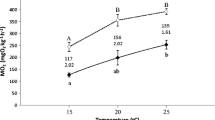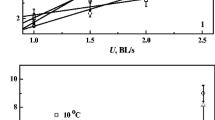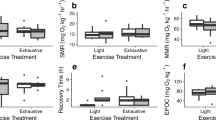Abstract
The effects of temperature on resting oxygen consumption rate (MO2rest) and excess post-exercise oxygen consumption (EPOC) after exhaustive exercise (chasing) were measured in juvenile southern catfish (Silurus meridionalis) (8.40 ± 0.30 g, n = 40) to test whether temperature has a significant influence on MO2rest, maximum post-exercise oxygen consumption rate (MO2peak) and EPOC and to investigate how metabolic scope (MS: MO2peak − MO2rest) varies with acclimation temperature. The MO2rest increased from 64.7 (10°C) to 160.3 mg O2 h−1 kg−1 (25°C) (P < 0.05) and reached a plateau between 25 and 30°C. The post-exercise MO2 in all temperature groups increased immediately to the peak values and then decreased slowly to a steady state that was higher than the pre-exercise MO2. The MO2peak did not significantly differ among the 20, 25 and 30°C groups, though these values were much higher than those of the lower temperature groups (10 and 15°C) (P < 0.05). The duration of EPOC varied from 32.9 min at 10°C to 345 min at 20°C, depending on the acclimation temperatures. The MS values of the lower temperature groups (10 and 15°C) were significantly smaller than those of the higher temperature groups (20, 25 and 30°C) (P < 0.05). The magnitude of EPOC varied ninefold among all of the temperature groups and was the largest for the 20°C temperature group (about 422.4 mg O2 kg−1). These results suggested that (1) the acclimation temperature had a significant effect on maintenance metabolism (as indicated by MO2rest) and the post-exercise metabolic recovery process (as indicated by MO2peak, duration and magnitude of EPOC), and (2) the change of the MS as a function of acclimation temperature in juvenile southern catfish might be related to their high degree of physiological flexibility, which allows them to adapt to changes in environmental conditions in their habitat in the Yangtze River and the Jialing River.


Similar content being viewed by others
Abbreviations
- MO2:
-
Oxygen consumption rate
- MO2rest:
-
Resting oxygen consumption rate
- MO2peak:
-
Peak post-exercise oxygen consumption rate
- EPOC:
-
Excess post-exercise oxygen consumption
- MS:
-
Metabolic scope
- ATP:
-
Adenosine triphosphate
- PCr:
-
Phosphocreatine
- U crit :
-
Critical swimming speed
- ANOVA:
-
One-way analysis of variance
- LSD:
-
Least significant difference
References
Black EC (1958) Hyperactivity as lethal factor in fish. J Fish Res Board Can 15:245–251
Børsheim E, Bahr R (2003) Effect of exercise intensity, duration and mode on post-exercise oxygen consumption. Sports Med 33(14):1037–1060
Brett JR (1971) Energetic responses of salmon to temperature. A study of some thermal relations in the physiology and freshwater ecology of sockeye salmon (Oncorhynchus nerka). Am Zool 11:99–113
Claireaux G, Lagardere JP (1999) Influence of temperature, oxygen and salinity on the metabolism of the European sea bass. J Sea Res 42:157–168
Claireaux G, Webber DM, Lagardere JP, Kerr SR (2000) Influence of water temperature and oxygenation on the aerobic metabolic scope of Atlantic cod (Gadus morhua). J Sea Res 44:257–265
Claireaux G, Couturier C, Groison AL (2006) Effect of temperature on maximum swimming speed and cost of transport in juvenile European sea bass (Dicentrarchus labrax). J Exp Biol 200:3420–3428
Cutts CJ, Metcalfe NB, Taylor AC (2002) Juvenile Atlantic salmon (Salmo salar) with relatively high standard metabolic rates have small metabolic scopes. Funct Ecol 16:73–78
Farrell AP (2007) Cardiorespiratory performance during prolonged swimming tests with salmonids: a perspective on temperature effects and potential analytical pitfalls. Phil Trans R Soc B 362:2017–2030
Fry FEJ (1947) Effects of environment on animal activity. Publ Ontario Fish Res Lab 55:1–62
Fu SJ, Xie XJ, Cao ZD (2005) Effect of meal size on postprandial metabolic response in southern catfish (Silurus meridionalis). Comp Biochem Physiol A 140:445–451
Fu SJ, Cao ZD, Peng JL (2007) Effect of feeding and fasting on excess post-exercise oxygen consumption in juvenile southern catfish (Silurus meridionalis Chen). Comp Biochem Physiol A 146:435–439
Fu SJ, Zeng LQ, Li XM, Pang X, Cao ZD, Peng JP, Wang YX (2009) Effect of meal size on excess post-exercise oxygen consumption in fishes with different locomotive and digestive performance. J Comp Physiol B 179:509–517
Gaesser GA, Brooks GA (1984) Metabolic bases of excess post exercise oxygen consumption: a review. Med Sci Sports Exerc 16:29–43
Hanna SK, Haukenes AH, Foy RJ, Buck CL (2008) Temperature effects on metabolic rate, swimming performance and condition of Pacific cod Gadus macrocephalus Tilesius. J Fish Biol 72:1068–1078
Hyndman CA, Kieffer JD, Benfey TJ (2003) The physiological response of diploid and triploid brook trout to exhaustive exercise. Comp Biochem Physiol A 134:167–179
Johnson TP, Bennett AF (1995) The thermal acclimation of burst swimming escape performance in fish: an integrated study of molecular and cellular physiology and organismal performance. J Exp Biol 198:2165–2175
Kieffer JD (2000) Limits to exhaustive exercise in fish. Comp Biochem Physiol A 126:161–179
Kieffer JD, Currie S, Tufts BL (1994) Effects of environmental temperature on the metabolic and acid-base responses of rainbow trout to exhaustive exercise. J Exp Biol 194:299–317
Lee GC, Farrell AP, Lotto A, MacNctt MJ, Hinch SG, Healey MC (2003a) The effect of temperature on swimming performance and oxygen consumption in adult sockeye (Oncorhynchus nerka) and coho (O. kisutch) salmon stocks. J Exp Biol 206:3239–3251
Lee GC, Farrell AP, Lotto A, Hinch SG, Healey MC (2003b) Excess post-exercise oxygen consumption in adult sockeye (Oncorhynchus nerka) and coho (O. kisutch) salmon following critical speed swimming. J Exp Biol 206:3253–3260
Lee GC, Devlin RH, Farrell AP (2003c) Swimming performance, oxygen consumption and excess post-exercise oxygen consumption in adult transgenic and ocean-ranched coho salmon. J Fish Biol 62:753–766
Lefrançois C, Claireaux G (2003) Influence of ambient oxygenation and temperature on metabolic scope and scope for heart rate in the common sole Solea solea. Mar Ecol Prog Ser 259:273–284
Li L, Cao ZD, Fu SJ (2007) Lactate, glycogen and glucose levels of juvenile Chinese catfish (Silurus asotus Linnaeus) in response to exhaustive exercise. Acta Hydrobiol Sin 31:880–885
Long TY, Zheng M, Guo WH, Hou YQ (2007) Applying the ecological amplitude to nutrition restrictive factors of Jialing River in the city zone of Chongqing. J Chongqing Univ China 30:81–85
Lowe CJ, Davison W (2006) Thermal sensitivity of scope for activity of Pagothenia borchgrevinki, a cryopelagic Antarctic nototheniid fish. Polar Biol 29:971–977
Luo YP, Xie XJ (2008) Effects of temperature on the specific dynamic action of the southern catfish, Silurus meridionalis. Comp Biochem Physiol A 149:150–156
McKenzie DJ, Serrine G, Pariccini G, Bronzi P, Bolis CL (1996) Effects of diet on responses to exhaustive exercise in Nile Tilapia (Oreochromis nilotica) acclimated to three different temperatures. Comp Biochem Physiol A 114:43–50
Milligan CL (1996) Metabolic recovery from exhaustive exercise in rainbow trout. Comp Biochem Physiol A 113:51–60
Priede IG (1977) Natural selection for energetic efficiency and relationship between activity level and mortality. Nature 267:610–611
Randall D, Brauner C (1991) Effects of environmental factors on exercise in fish. J Exp Biol 160:113–126
Scarabello M, Heigenhauser GJ, Wood CM (1992) Gas exchange, metabolite status and excess post-exercise oxygen consumption after repetitive bouts of exhaustive exercise in juvenile rainbow trout. J Exp Biol 167:155–169
Steffensen JF (1989) Some errors in respirometry of aquatic breathers: how to avoid and correct for them. Fish Physiol Biochem 6:49–59
Vijayan MM, Mommsen TP, Glemet HC, Moon TW (1996) Metabolic effects of cortisol treatment in a marine teleost, the sea raven. J Exp Biol 199:1509–1514
Waller U (1992) Factors influencing routine oxygen uptake in turbot, Scophthalmus maximus. J Appl Ichthyol 8:62–71
Wang Y, Heigenhauser GJF, Wood CM (1994) Integrated responses to exhaustive exercise and recovery in rainbow trout white muscle: acid-base, phosphogen, carbohydrate, lipid, ammonia, fluid volume and electrolyte metabolism. J Exp Biol 195:227–258
Wilson RS, Franklin CE (1999) Thermal acclimation of locomotor performance in tadpoles of the frog Limnodynastes peronii. Comp Physiol Biol B 169:445–451
Wood CM (1991) Acid-base and ion balance, metabolism, and their interactions after exhaustive exercise in fish. J Exp Biol 160:285–308
Zeng LQ, Fu SJ, Cao ZD (2007) Diurnal rhythm of standard metabolism in southern catfish (Silurus meridionalis Chen). Fish Sci China 26:539–542
Zeng LQ, Cao ZD, Fu SJ, Peng JL, Wang YX (2009) Effect of temperature on swimming performance in juvenile southern catfish (Silurus meridionalis). Comp Biochem Physiol A 153:125–130
Acknowledgments
We are very grateful to post-graduates X. M. Li, K. G. Li, Y. P. Chen, and X. Pang for their assistance in conducting experiments and fish husbandry. We also thank Mrs. J. L. Peng for her kind help in the present study. This study was funded by the National Science Foundation of China (NSFC 30700087) grant to S.J.F. and the Research Project of Chongqing Education Committee (KJ080823) granted to Z.D.C.
Author information
Authors and Affiliations
Corresponding author
Rights and permissions
About this article
Cite this article
Zeng, LQ., Zhang, YG., Cao, ZD. et al. Effect of temperature on excess post-exercise oxygen consumption in juvenile southern catfish (Silurus meridionalis Chen) following exhaustive exercise. Fish Physiol Biochem 36, 1243–1252 (2010). https://doi.org/10.1007/s10695-010-9404-9
Received:
Accepted:
Published:
Issue Date:
DOI: https://doi.org/10.1007/s10695-010-9404-9




